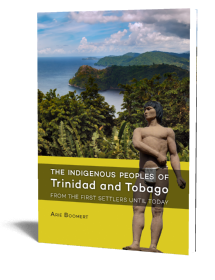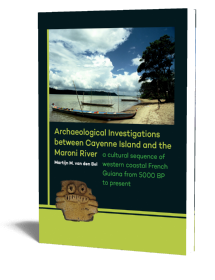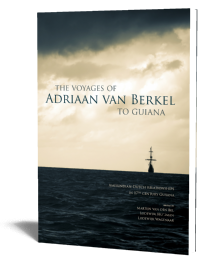A History of Suriname
Hans Buddingh` | 2022

A History of Suriname
Hans Buddingh` | 2022
Paperback ISBN: 9789464261394 | Hardback ISBN: 9789464261400 | Imprint: Sidestone Press | Format: 182x257mm | 494 pp. | Language: English | 49 illus. (bw) | 8 illus. (fc) | Keywords: history; Caribbean; Latin America; multi-ethnic nation; indigenous peoples; slavery; Maroons; military coups; drug trafficking; gold; oil; Amazon forest; populism; democracy | download cover
Read online 1295 times
- Digital & Online access
-
Buy via Sidestone (EU & UK)
-
Buy via our Distributors (WORLD)
For non-EU or UK destinations you can buy our books via our international distributors. Although prices may vary this will ensure speedy delivery and reduction in shipping costs or import tax. But you can also order with us directly via the module above.
UK international distributor
USA international distributor
-
Bookinfo
Paperback ISBN: 9789464261394 | Hardback ISBN: 9789464261400 | Imprint: Sidestone Press | Format: 182x257mm | 494 pp. | Language: English | 49 illus. (bw) | 8 illus. (fc) | Keywords: history; Caribbean; Latin America; multi-ethnic nation; indigenous peoples; slavery; Maroons; military coups; drug trafficking; gold; oil; Amazon forest; populism; democracy | download cover
Read online 1295 times

We will plant a tree for each order containing a paperback or hardback book via OneTreePlanted.org.
A History of Suriname presents the first comprehensive overview in English to cover the distant past as well as current events in the former Dutch colony located on the Wild Coast of South America where Spanish and English adventurers once presumed El Dorado. This study concerns original Indigenous inhabitants, the arrival of enslaved Africans who toiled away on plantations, the colonial economy with its trade relations with both Europe and North America, the immigration of Asian indentured labourers, to conclude with more recent events of the 20th and 21st century.
The present publication offers an exceptionally profound insight into the socio-political developments of a multi-ethnic nation. In spite of intercultural tensions, Suriname’s capital Paramaribo houses a synagogue and a mosque harmoniously located right next to each other. While rather similar Caribbean states are also referred to, special attention is further paid to the remarkable struggle of the Maroons, those rebellious slaves who fled plantations, created their own communities deep in the jungle and preserved elements of their time-honoured West African culture. Maroons in part continue to reside in traditional villages, while their socio-political emancipation on a national level takes shape.
In recent years, Suriname has attracted further attention from the outside world after a military coup staged during the 1980s caused Suriname to transform into a narcocracy with strong populist traits. Between 2010 and 2020, the initiator of this putsch officiated as the democratically elected president. Suriname was thus the only country in the world led by a head of state who had been convicted of drug trafficking, was on trial for multiple political assassinations and then convicted of this crime while still in office. How could all this happen? A History of Suriname attempts to answer that as well as many other questions.
Preface
Chapter 1. Original inhabitants and the first colonisation
Chapter 2. The Society of Suriname
2.1 Introduction
2.2 The government of Suriname, a continuous struggle for power
2.3 The fight of the cabalists
Chapter 3. The white colonial society
3.1 Arrival of the first white colonists
3.2 Jewish immigration
3.3 Social structure
3.4 A society without cohesion
3.5 Sexual relations of whites with people of colour and Black people
3.6 Education
3.7 Religion
Chapter 4. Slavery
4.1 Introduction
4.2 Demographic developments
4.3 Supervising the enslaved workforce
4.4 Slaves in their own world
4.5 Free people of colour and free Black people
Chapter 5. Marronage
5.1 Introduction
5.2 The Boni-Maroon Wars (1765-1778 and 1789-1793)
Chapter 6. Inhabitants of the inland
6.1 The formation of Maroon societies
6.2 Amerindians in the colonial society
Chapter 7. Emancipation of the enslaved
Chapter 8. The economy (1651-1863)
Chapter 9. Transforming the colonial society (1863-1942)
9.1 Immigration of indentured labourers from Asia
9.2 Creoles after emancipation
9.3 Tensions within a plural society
9.4 The position of Asian populations
9.5 Social struggle during the 1930s
9.6 Change in assimilation policy
Chapter 10. Transforming the plantation economy
Chapter 11. Towards autonomy and independence
11.1 World War II
11.2 Political mobilisation
11.3 Fraternization policy and elite-cartel democracy
11.4 Independence and failed nation-building
11.5 The Dutch stance on independence
11.6 The post-1975 malaise
Chapter 12. Economic development (1945-1980)
Chapter 13. Military rule (1980-1987)
13.1 The 25 February Movement
13.2 Dialogue with ‘old’ politicians
13.3 Economic developments
Chapter 14. Return to civilian rule
14.1 Constitution and elections
14.2 War in the Interior
14.3 The so-called telephone coup
14.4 The Nieuw Front-led government
14.5 A more business-like aid relationship and restoring financial stability
Chapter 15. Contours of informal power and narcocracy
15.1 The business elite, a divisive force within the Nieuw Front
15.2 Old parties in a minority position for the first time
15.3 A government of ‘a boss and bosses’
15.4 Crisis in relations with the Netherlands
15.5 Mass demonstrations against malpractices and corruption
15.6 Crisis after malpractice and corruption
Chapter 16. Suriname in the 21st century
16.1 Introduction
16.2 Old parties return to power
16.3 Political emancipation of Maroons
16.4 Desi Bouterse, President
16.5 From sheriff to President
16.6 Economy in transition
Chapter 17. Epilogue
Hans Buddingh`
Hans Buddingh’ graduated in economics and works as an editor for the leading Dutch newspaper and news site NRC. For this medium he frequently travelled to Suriname. In 1987 he published (with a co-author) Surinam, politics, economics and society. And in 1994 he wrote (with a co-author) the revealing book De Danser about the Surinamese drug cartel and its ties with the Colombian drug mafia. He has also contributed to several other book publications about Suriname.
Abstract:
A History of Suriname presents the first comprehensive overview in English to cover the distant past as well as current events in the former Dutch colony located on the Wild Coast of South America where Spanish and English adventurers once presumed El Dorado. This study concerns original Indigenous inhabitants, the arrival of enslaved Africans who toiled away on plantations, the colonial economy with its trade relations with both Europe and North America, the immigration of Asian indentured labourers, to conclude with more recent events of the 20th and 21st century.
The present publication offers an exceptionally profound insight into the socio-political developments of a multi-ethnic nation. In spite of intercultural tensions, Suriname’s capital Paramaribo houses a synagogue and a mosque harmoniously located right next to each other. While rather similar Caribbean states are also referred to, special attention is further paid to the remarkable struggle of the Maroons, those rebellious slaves who fled plantations, created their own communities deep in the jungle and preserved elements of their time-honoured West African culture. Maroons in part continue to reside in traditional villages, while their socio-political emancipation on a national level takes shape.
In recent years, Suriname has attracted further attention from the outside world after a military coup staged during the 1980s caused Suriname to transform into a narcocracy with strong populist traits. Between 2010 and 2020, the initiator of this putsch officiated as the democratically elected president. Suriname was thus the only country in the world led by a head of state who had been convicted of drug trafficking, was on trial for multiple political assassinations and then convicted of this crime while still in office. How could all this happen? A History of Suriname attempts to answer that as well as many other questions.
Contents
Preface
Chapter 1. Original inhabitants and the first colonisation
Chapter 2. The Society of Suriname
2.1 Introduction
2.2 The government of Suriname, a continuous struggle for power
2.3 The fight of the cabalists
Chapter 3. The white colonial society
3.1 Arrival of the first white colonists
3.2 Jewish immigration
3.3 Social structure
3.4 A society without cohesion
3.5 Sexual relations of whites with people of colour and Black people
3.6 Education
3.7 Religion
Chapter 4. Slavery
4.1 Introduction
4.2 Demographic developments
4.3 Supervising the enslaved workforce
4.4 Slaves in their own world
4.5 Free people of colour and free Black people
Chapter 5. Marronage
5.1 Introduction
5.2 The Boni-Maroon Wars (1765-1778 and 1789-1793)
Chapter 6. Inhabitants of the inland
6.1 The formation of Maroon societies
6.2 Amerindians in the colonial society
Chapter 7. Emancipation of the enslaved
Chapter 8. The economy (1651-1863)
Chapter 9. Transforming the colonial society (1863-1942)
9.1 Immigration of indentured labourers from Asia
9.2 Creoles after emancipation
9.3 Tensions within a plural society
9.4 The position of Asian populations
9.5 Social struggle during the 1930s
9.6 Change in assimilation policy
Chapter 10. Transforming the plantation economy
Chapter 11. Towards autonomy and independence
11.1 World War II
11.2 Political mobilisation
11.3 Fraternization policy and elite-cartel democracy
11.4 Independence and failed nation-building
11.5 The Dutch stance on independence
11.6 The post-1975 malaise
Chapter 12. Economic development (1945-1980)
Chapter 13. Military rule (1980-1987)
13.1 The 25 February Movement
13.2 Dialogue with ‘old’ politicians
13.3 Economic developments
Chapter 14. Return to civilian rule
14.1 Constitution and elections
14.2 War in the Interior
14.3 The so-called telephone coup
14.4 The Nieuw Front-led government
14.5 A more business-like aid relationship and restoring financial stability
Chapter 15. Contours of informal power and narcocracy
15.1 The business elite, a divisive force within the Nieuw Front
15.2 Old parties in a minority position for the first time
15.3 A government of ‘a boss and bosses’
15.4 Crisis in relations with the Netherlands
15.5 Mass demonstrations against malpractices and corruption
15.6 Crisis after malpractice and corruption
Chapter 16. Suriname in the 21st century
16.1 Introduction
16.2 Old parties return to power
16.3 Political emancipation of Maroons
16.4 Desi Bouterse, President
16.5 From sheriff to President
16.6 Economy in transition
Chapter 17. Epilogue
Hans Buddingh`
Hans Buddingh’ graduated in economics and works as an editor for the leading Dutch newspaper and news site NRC. For this medium he frequently travelled to Suriname. In 1987 he published (with a co-author) Surinam, politics, economics and society. And in 1994 he wrote (with a co-author) the revealing book De Danser about the Surinamese drug cartel and its ties with the Colombian drug mafia. He has also contributed to several other book publications about Suriname.
- Digital & Online access
-
Buy via Sidestone (EU & UK)
-
Buy via our Distributors (WORLD)
For non-EU or UK destinations you can buy our books via our international distributors. Although prices may vary this will ensure speedy delivery and reduction in shipping costs or import tax. But you can also order with us directly via the module above.
UK international distributor
USA international distributor
- Browse all books by subject
-
Search all books

We will plant a tree for each order containing a paperback or hardback book via OneTreePlanted.org.
You might also like:
© 2025 Sidestone Press KvK nr. 28114891 Privacy policy Sidestone Newsletter Terms and Conditions (Dutch)








